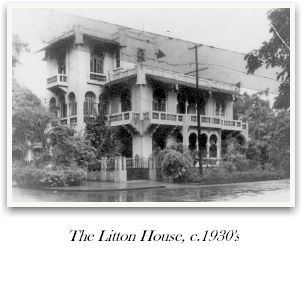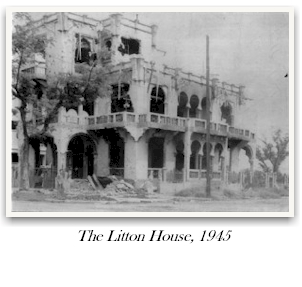|
REMINISCENCES
OF THE BATTLE OF MANILA
February 3 - March 3, 1945
by
James Litton
___________________________________
The Battle of Manila was the only urban battle waged by the American Armed
Forces in the Pacific during World War II.
In the evening of February 3, 1945, American motorized units, with
the aid of Filipino guerillas, stormed the gates of the University of
Santo Tomas (UST) to liberate American and other civilian allies interned
there from around the start of the Japanese occupation of Manila on
January 2, 1942. The first
American air raid over Manila on September 21, 1944, was the prologue to
the forthcoming battle that would bring about the destruction of the city
that we all then fondly and proudly called the Pearl of the Orient.
Since 1936, my family had lived in Ermita in a house located in the
corner of Isaac Peral (now U. N. Avenue) and Florida (now M. Orosa)
Streets. My father, George
Litton, Sr., had bought this house from the Spanish Moreta family. It was
a beautiful three storey Moorish styled edifice with arches, balconies,
and a roof garden. The Florida Street side of the house faced the
Episcopalian Cathedral of St. Mary and St. John on whose site now stands
the Manila Pavilion Hotel.
Ermita was a quaint, distinct, and idyllic residential area. It had
a character of its own, different from that of Malate, Paco, or Pasay. It
was, in the words of Carmen Guerrero Nakpil, “[A] charming colonial town
built by Europeans and Americans….” Many Spanish families lived in Ermita
as did other expatriates. It was common to read a doctor’s shingle hanging
outside his office describing the medical practitioner in Spanish as a
“Medico-Cirujano” and signs of “Cuidado por los Perros” hung on the gates
of houses so as to warn passers-by that the house was guarded by fierce
dogs. Isaac Peral Street was by far the most beautiful street in Manila.
Both sides of the street were bordered by wide clean sidewalks and giant
Acacia trees whose arching branches formed a tunnel like bower extending
from Taft Avenue up to Dewey Boulevard (now Roxas Boulevard).
I had turned eleven in June of 1944. We were then in the middle of
the third year of the Japanese occupation and I was no longer attending
school. I did return to La Salle as soon as it had re-opened in 1942,
after briefly attending classes at St. Paul in Herran Street (now Pedro
Gil). I had to leave La Salle after I had finished the third grade because
transportation was getting very difficult. No cars were running as
gasoline was not available. I would go to La Salle to attend my classes by
taking the tranvia [streetcar] from San Marcelino Street but even that had
become very difficult as the tranvias had become always jam-packed.
Passengers would hang by the windows or even climb up the roof of the
tranvias just to get a ride. My mother transferred me to Santa Teresa in
San Marcelino Street, a girl’s school run by Belgian nuns that accepted
boys up to the fifth grade. Santa Teresa was just a fifteen minute walk
from our house. In May or June of 1944, however, the Japanese military
took over the premises of Santa Teresa and thus I no longer had a school
to go to.

Nuns and Members of the Japanese Army in Manila
In the early morning of September 21, 1944, I went to Wallace
Field to meet my close friend Henry Chu. Wallace Field was the site of
the famous annual Manila Carnival. It is now part of the eastern section
of Rizal Park. Henry Chu
lived in San Luis Street (now T, M. Kalaw) at the Queens Hotel (a
precursor to our present motels), which was owned and managed by his
father. Our carefree morning was suddenly interrupted by what, at first,
we thought were airplanes in practice maneuvers. We suddenly realized
that there was something terribly wrong when one plane burst into flames
and tracer bullets began to lace the clear Manila sky. I stood in awe,
seemingly unmindful of the danger, as I fixed my gaze upon a single
engine plane descending very fast, almost at an angle of 90 degrees, and
releasing its bombs at a Japanese ship docked at the South Harbor. My
friend Henry grabbed my arm and pulled me as we both ran to his father’s
hotel and into an improvised air raid shelter dug at the ground floor.
There were many more air raids after the first one in September 21.
As soon as we would hear the air raid siren announcing an imminent attack,
my brothers and I would rush to our roof garden to get a ring side-view of
the drama unfolding before our eyes. The air raids became more frequent
around the end of October. By then, we had almost daily air raids by
American dive bombers and later by a new American fighter-bomber, which we
later learned to be the P-38. This fighter-bomber had two engines, one on
each of its two separate fuselages, both of which were connected to each
other in the middle by the cockpit
The skies, during and after an air raid, would be darkened by the
mushroom-like puffs of exploding anti-aircraft shells aimed at the raiding
airplanes. These shells would rain the ground with deadly shrapnel, which
we kids would collect and keep. Around this time, there occurred two
tragic incidents that I still clearly remember.
It was, as I recall, around the first week of November when early
in the morning American dive bombers again flew over Manila.
As we watched American airplanes swooping over Japanese ships
anchored in Manila bay, amidst a maze of tracer bullets and bursts of
anti-aircraft shells, we heard the groaning sound of an American dive
bomber coming towards us from the east. The sound of its engine indicated
that it was in trouble. As we watched this plane flying low and heading
west towards us, we were horrified to see that it had jettisoned its load
of a single bomb, which began its descent directly towards us! We all
thought the bomb would hit us but it passed overhead and ended its deadly
descent in a loud horrifying explosion, shaking our house and the ground
beneath us. We later learned that the jettisoned bomb had hit the house of
Dr. Luis Guerrero, in Isaac Peral Street, just a few blocks from our
house. Carmen Guerrero Nakpil, in her book Myself, Elsewhere, wrote:
“Three houses in the block that we Guerreros shared were rubble and two
more were severely damaged. Tio Luis’ son, Dr. Luisito … and the three
maiden aunts, Liling, Felisa, and Neng were killed.”
I remember the date well. It was in the morning of January 8, 1945,
when we heard the air raid siren announcing another air raid. From the
roof garden of our house, we were greeted by the magnificent sight of a
squadron of American four engine bombers flying from the west at a
relatively low altitude. We could clearly see its four engines and its
twin rear tail. (We would later learn that these were B-24s Liberators).
The Japanese anti-aircraft barrage started and the sky was soon
pock-marked by its black puffs marking where the shells had exploded.
Frank Stagner, a twelve year old American interned at the University of
Santo Tomas (UST), was also looking at this squadron of American bombers
and he recalls that:
“My younger 10 year old brother Lawrence and I were crouched under
our shanty and could hear the roar of the approaching Bomb Group and the
loud cracks of the bursting enemy AA. Like a couple of nit wits, we stood
outside and in awe of the approaching B-24 Bombers with the puffs of the
airbursts all about the flight. I definitely observed a flash and AA burst
under a trailing bomber. A tiny red glow was then observed under the
bomber and began generating a long slender trail of brown smoke. As the
B-24s neared, the flames began to grow much larger and with a thicker
trail of smoke. Shortly after the stricken bomber passed, it suddenly went
into a sudden dive to the right and away from the Group formation. I
witnessed and felt a horrendous explosion where the B-24 should have been.
I was able to observe only three men with chutes. One was at a much higher
altitude with what I considered a normally opened one. This man was
rapidly drifting back to the target area.”
What Frank Stagner did not see was that one of the crew that had
bailed out had fallen and drifted towards Ermita and the bay. From our
roof garden perch, we could clearly see this hapless American dangling
from his chute as it descended and drifted towards Dewey Boulevard. When
the chute was nearly overhead and the man strapped to it was clearly
visible, we suddenly heard a series of gunshots. The Japanese were
shooting this completely helpless man dangling on a parachute! The
barbarity of this incident was shocking even to an eleven year old boy!
Many years later, after the war had ended, I would learn the fate of the
crew of this unfortunate B-24 from Sascha Jean Jansen, nee Weinzheimer, an
American friend, interned in the UST, and daughter of the former owner of
the Canlubang Sugar Estate.
Go to Page 2
|



